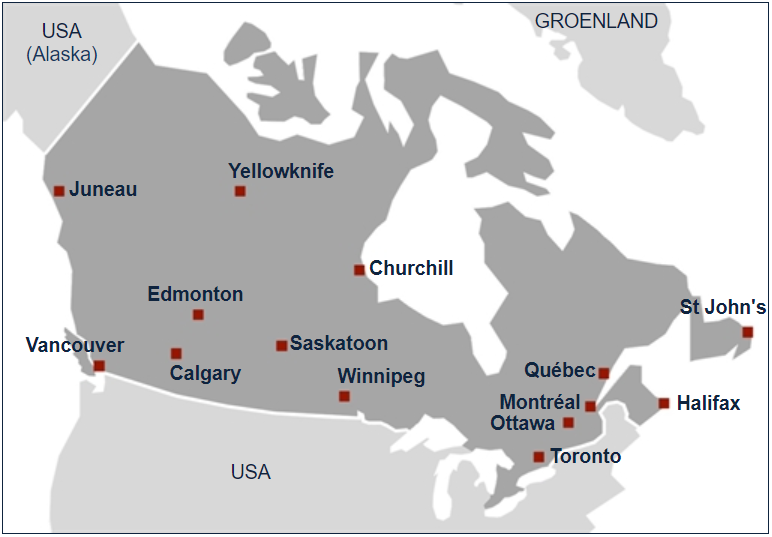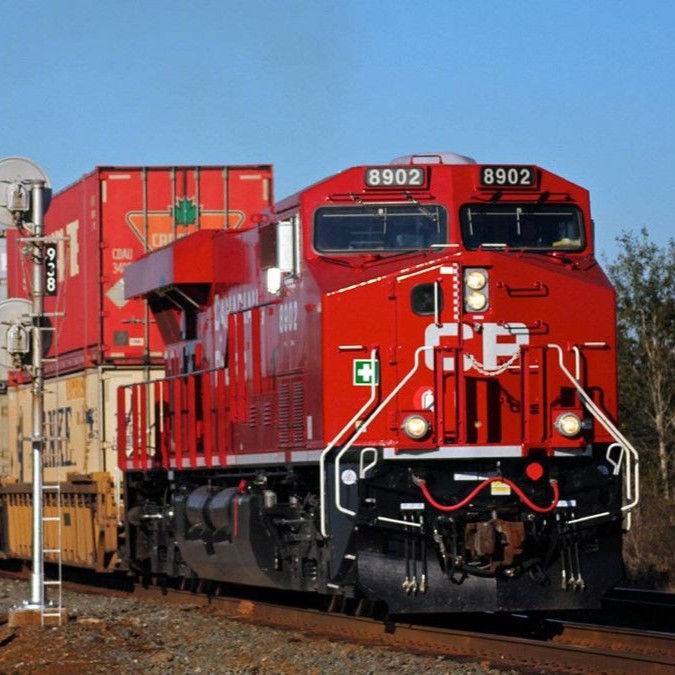Population: 39,507 million inhabitants – Administrative language: english (french in Québec)
Political capital: Ottawa
Political system: Canada’s political system is based on that of the United Kingdom. It is a constitutional monarchy with the Prime Minister as head of government. Canada is a federation whose federated states, known as provinces, enjoy complete autonomy, each within its own territory, with sovereignty extending to many areas (the far north, which is sparsely populated, has a special organisation).

Brief rail characteristics:
• UIC code : no
• Main track gauge: 1435mm
• Main electrification: no
• High Speed > V250 : no
Rail transport
• History of rail in Canada
• Details of institutional organisation
• Canadian rail news highlights
Notified bodies
• Regulation : Canadian Transportation Agency (CTA)
• Security : Transportation Safety Board of Canada (TSB)
Public transport
• National / local and regional authorities
The 10 top ranking cities:
• Toronto, Montréal, Calgary, Ottawa, Edmonton, Winnipeg, Mississauga, Vancouver, Brampton, Hamilton
Organisation of rail transport in Canada
Manager of the main railway network
97% of the tracks belong mainly to Canadian National (CN) and Canadian Pacific (CP).
Main historical railway company
Two major operators: Canadian National (CN, a state-owned company) and Canadian Pacific (CP, a private company).
Liberalisation (depends on the legal scope given to it)
1978 : transfert des services voyageurs du CP à Via rail, nouvelle entreprise d’État
1987 : déréglementation partielle du fret ferroviaire.
1995 : privatisation du CN après avoir été un opérateur public pendant 75 ans
Mainline and international train services
Operated exclusively by Via rail, which serves 121 stations on a 12,500 km network
The Quebec – Montreal – Ottawa – Toronto route accounts for more than 70% of passengers
International traffic with Amtrak on a few routes to the United States, such as Montreal-New York, Toronto-New York and Vancouver-Seattle-Portland.
Alternative mainline operators
Le Rocky Mountaineer depuis 1990 (Vancouver-Jaspers)
Local / regional train services
Provincially-owned operators such as Go Transit (Ontario), Exo (ex-AMT) between Montreal and Quebec and West Coast Express around Vancouver.
Other local and regional operators
Not relevant in the Canadian case
Freight train services
CN and CP are the two major rail freight operators in Canada and are both Class I shortlines (revenues in excess of $250 million for the past two years).
Class II shortlines are defined as railways with annual revenues of less than $250 million for two consecutive years.
Alternative rail freight operators
All the operators described above.
Bus / lightrail / metro
The regions are responsible for programming, planning and supervising their public transport, as are the major cities.
Glossary of rail transport in Canada

Infrastructure
◼ Main network manager:
• 97% Canadian National (CN) and Canadian Pacific (CP)
• 47,711km of lines
◼ Others secondary network managers:
• —
◼ Passenger stations :
• —
◼ Companies registered:
• 26

Rolling stock:
◼ Authorized vehicles:
• Electric vehicles
• Autonomous vehicles
• Emu
• Dmu
• Railway cars
• Freight wagons
• Others
◼ Suppliers:
• History of the industry
• Industry today

Passenger services:
• Former national traffic
• from CN to VIA Rail
• EXO Montreal
• Ontario Northland Railway
• GO Transit
• West Coast Express
• Capital Railway
• Cross-border traffic
◼ international trafic :
• Traffic organisation
◼ Flow analysis:
• Main lines / local lines
• Modal shares & Economy

Freight services
◼ Industry sectors:
• Steel
• Chemical
• Intermodal
• Wood / Paper
• Others
◼ Operators:
• CN
• CP
◼ Canadian operations abroad:
• CPKC
◼ Infrastructure :
• little freight stations
• Marshalling yards
• Main north-south routes
• Ports
◼ Flow analysis:
• Main freight lines
• Modal share & Economy